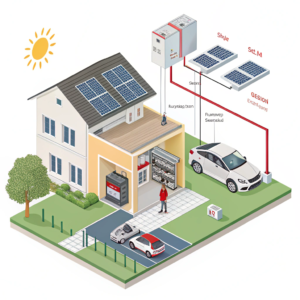Development and Application Prospects of Solar Energy Storage Technologies
•
Development and Application Prospects of Solar Energy Storage Technologies
Have you ever wondered how we can effectively harness the sun's abundant energy for round-the-clock use?
Solar energy storage technologies enable continuous power supply by capturing excess solar energy during peak production for use during non-sunlight hours, addressing intermittency issues and enhancing renewable energy utilization.
Research Advances in High-Efficiency Energy Conversion and Storage Materials
Why are recent breakthroughs in storage materials critical for solar energy's future?
New high-efficiency materials like perovskite solar cells and solid-state batteries are revolutionizing solar energy storage, offering higher energy density, longer lifespan, and improved safety compared to conventional options.
![Cutting-edge solar energy storage materials in a laboratory setting]

Advanced Energy Storage Materials
Breakthrough Materials for Solar Storage
The solar energy storage landscape is being transformed by several key material innovations:
| Material Type | Energy Density | Cycle Life | Key Advantages |
|---|---|---|---|
| Lithium-Ion Batteries | 200-250 Wh/kg | 2000-5000 | Mature technology |
| Solid-State Batteries | 400-500 Wh/kg | 10,000+ | Improved safety |
| Perovskite Solar Cells | N/A | N/A | 31% efficiency |
These materials are addressing critical challenges:
- Perovskite solar cells: Achieving record efficiencies while being potentially cheaper to manufacture
- Solid-state batteries: Eliminating flammable liquid electrolytes for safer operation
- Flow batteries: Offering scalable, long-duration storage solutions
Recent studies show perovskite-silicon tandem cells have surpassed 32% efficiency1, while new solid-state designs demonstrate unprecedented cycle life2.
Perovskite solar cells have higher efficiency potential than silicon cells.True
Perovskite cells have demonstrated lab efficiencies exceeding 31%, surpassing traditional silicon.
All new battery technologies are already commercially available.False
Many advanced technologies like solid-state batteries are still in development stages.
Integration and Optimisation Strategies of Energy Storage Systems in Solar Power Generation
How can we seamlessly blend storage systems with existing solar infrastructure?
Effective integration of solar storage requires smart energy management systems, hybrid configurations, and grid-scale solutions that balance production, storage, and demand patterns for optimal renewable energy utilization.
![Solar farm with integrated battery storage system]
Grid-Scale Solar Storage Integration
System Integration Approaches
Modern solar-storage integration employs multiple strategic approaches:
-
DC-Coupled Systems
- Direct connection between solar panels and batteries
- Minimizes conversion losses (~5% more efficient)
- Ideal for new installations
-
AC-Coupled Systems
- Compatible with existing solar installations
- More flexible installation locations
- Easier to expand capacity
-
Hybrid Inverters
- Single unit manages both solar and storage
- Reduced equipment costs
- Simplified maintenance
Industry data shows DC-coupled systems can achieve 94-96% round-trip efficiency3 compared to 88-92% for AC-coupled alternatives. Emerging virtual power plant (VPP) technologies are enabling aggregated residential storage systems to provide grid services4, creating new revenue streams for system owners.
DC-coupled systems are more efficient than AC-coupled systems.True
DC-coupling avoids multiple energy conversions, preserving more usable energy.
Virtual power plants only benefit utility companies.False
VPPs create value for both utilities and participating homeowners through shared benefits.
Key Technical Challenges of Energy Storage Safety and Management Systems
What are the critical hurdles in making solar energy storage safer and more reliable?
Solar energy storage systems face technical challenges including thermal management, battery degradation, and fire safety, requiring advanced monitoring, innovative cooling solutions, and fail-safe mechanisms to ensure long-term reliability.
![Engineers inspecting large-scale battery storage systems]
Energy Storage Safety Monitoring
Addressing Storage System Challenges
The industry is tackling several key technical challenges:
-
Thermal Runaway Prevention
- Advanced cooling systems (liquid vs. air)
- Thermal runaway detection algorithms
- Fire suppression systems
-
Battery Management Systems (BMS)
- State-of-charge balancing
- Depth-of-discharge optimization
- Cell voltage monitoring
-
Cycling Durability
- Advanced charge controllers
- Temperature-compensated charging
- Predictive maintenance algorithms
Recent safety standards like UL 9540A provide test methods for energy storage systems5, while new AI-driven BMS solutions can predict battery failures with 92% accuracy6 before they occur. Thermal management remains crucial, with studies showing proper temperature control can extend battery life by up to 30%7.
Proper thermal management can significantly extend battery life.True
Maintaining optimal operating temperatures prevents accelerated degradation.
Current battery safety standards cover all potential failure modes.False
Safety standards continue to evolve as new failure mechanisms are identified.
Conclusion
Solar energy storage technologies are rapidly advancing through material innovations, smarter integration, and enhanced safety measures, paving the way for widespread renewable energy adoption.
- Documents perovskite-silicon tandem cell efficiency breakthroughs. ↩
- Presents latest research on solid-state battery longevity. ↩
- NREL study comparing storage system configurations. ↩
- Explains virtual power plant benefits and operations. ↩
- Outlines rigorous safety testing protocols. ↩
- Details AI applications in battery health monitoring. ↩
- Research on temperature impact on battery lifespan. ↩




